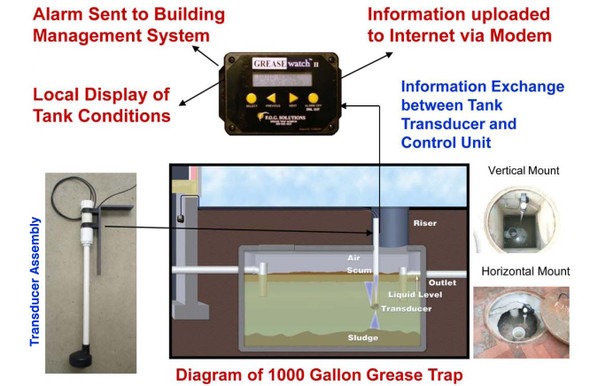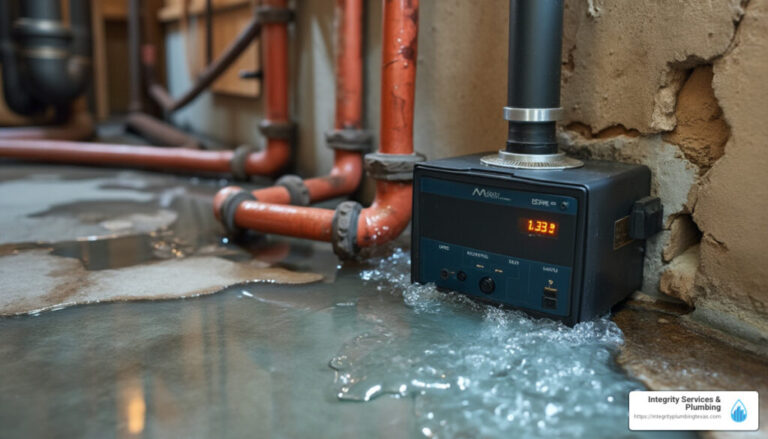Top 5 Grease Trap/Interceptor Monitoring Systems for 2026
Managing fats, oils, and grease (FOG) in commercial kitchens is critical to prevent clogs, fines, and environmental harm. Modern grease interceptor monitoring systems use sensors and smart alerts to optimize pumping schedules and ensure compliance. Below we rank the top 5 systems available in the U.S., scoring each on a 60-point scale across six criteria: Sensor Accuracy & Range, Integration & Remote Access, Ease of Installation & Retrofit, Data Logging & Compliance Reporting, Durability & Certifications, and Value & Support (10 points each). We cover technical specs, pros/cons, ideal use cases, and provide manufacturer links for each.
🥇 Zurn SmartPro™ Grease Interceptor Monitoring System

Overview: The Zurn SmartPro is a leading smart monitoring system for grease interceptors, offering real-time ultrasonic sensing of grease, oil, and solids levels. It was the first to use patented ultrasonic sensors instead of clog-prone floatsblog.zurn.com, providing highly reliable measurements. SmartPro supports wireless data via RF, cellular, or cloud gateway connectivityblog.zurn.com, allowing remote monitoring through a web dashboard or building automation system (BAS). A battery-powered tank unit and a wall-mounted gateway make installation quick (often under 60 minutesblog.zurn.com). This system is backed by Zurn’s nationwide support network and is deployed in restaurants, chains, and institutions to reduce pump-outs and prevent overflowsblog.zurn.com.
- Sensor Accuracy & Range: 9/10 – Ultrasonic transducers measure grease/oil and sediment levels with ~1-inch accuracydrain-tech.com. The sensor distinguishes grease and sludge layers in real time, though heavy FOG buildup may require occasional cleaning of the sensor. It eliminates direct contact probes (no floats to foul)blog.zurn.com.
- Integration & Remote Access: 10/10 – Offers flexible connectivity: wireless radio (≈300 ft range) and cellular transmission to a cloud portaldrain-tech.com. Supports text/email alerts and BAS integration for alarmsblog.zurn.com. Temperature and even battery status are monitored remotelyblog.zurn.com, ensuring you’re always informed.
- Ease of Installation & Retrofit: 10/10 – The SmartPro is designed for retrofit ease. A battery-powered tank unit installs in the interceptor (no hard wiring in the pit) and communicates wirelesslydrain-tech.com. The gateway and alarm panel plug into standard 120V AC outlets. Installation typically takes <1 hourblog.zurn.com with minimal downtime.
- Data Logging & Compliance Reporting: 9/10 – The system provides continuous level data and logs pump-out events to verify proper maintenanceblog.zurn.comblog.zurn.com. A cloud dashboard or reports can document compliance for inspectors. (One Zurn client used SmartPro data to cut pump frequency from monthly to quarterly, saving ~$720k/year across 200 sitesblog.zurn.com.)
- Durability & Certifications: 9/10 – The tank unit is NEMA 4X waterproof and corrosion-resistant. The ultrasonic sensor is fully potted for harsh environments. SmartPro is UL/cUL compliant and designed specifically for interceptor use (temperature-tolerant, grease-proof). Battery life is multiple years, and the system alerts for low batteryzurn.com.
- Value & Support: 8/10 – While the upfront cost is significant (typically ~$5k+ per system), the ROI can be high due to reduced pump-outs and prevented blockagesblog.zurn.com. Zurn provides U.S.-based support and has an established distributor network. No ongoing fees if using local RF setup; a modest annual fee applies for cellular/cloud service.
Total Score: 55/60
Technical Specifications: Ultrasonic level sensor (non-contact); monitors grease layer, oil, solids, total liquid and temperatureblog.zurn.com. Battery-powered tank module (5+ year lithium) with 100–300 ft wireless RF rangedrain-tech.com. Gateway with LTE cellular or LAN connectivity; local audible/visual alarm panel. Power: 120V AC for gateway/alarm, battery for tank unit. Integration: cloud portal and SMS/email alerts; optional dry contacts for BAS. UL listed components.
Pros: Very comprehensive monitoring (multi-layer sensing of grease, solids, liquid)blog.zurn.com; real-time remote data access; easy retrofit with minimal wiring; proven in large-scale deployments (e.g. chain restaurants) with documented cost savingsblog.zurn.com; strong manufacturer support (Zurn).
Cons: Higher initial cost than basic alarms; requires annual cell service fee for cloud usedrain-tech.com; ultrasonic sensor can require cleaning in heavy FOG environments (to prevent grease coating).
Ideal Use Cases: Restaurants, cafeterias, and grocery stores aiming to optimize pump-out frequency and avoid sewer clogs. Facility managers who need compliance records and want integration with building management systems. Great for multi-site chains monitored by a service provider (e.g. plumbing contractors like JPG use SmartPro to remotely manage client interceptorsblog.zurn.com).
Manufacturer/Product Page: See Zurn’s SmartPro overviewblog.zurn.comblog.zurn.com and case study for real-world resultsblog.zurn.com.
🥈 Drain-Net GreaseWatch Interceptor Monitor (GW Series)
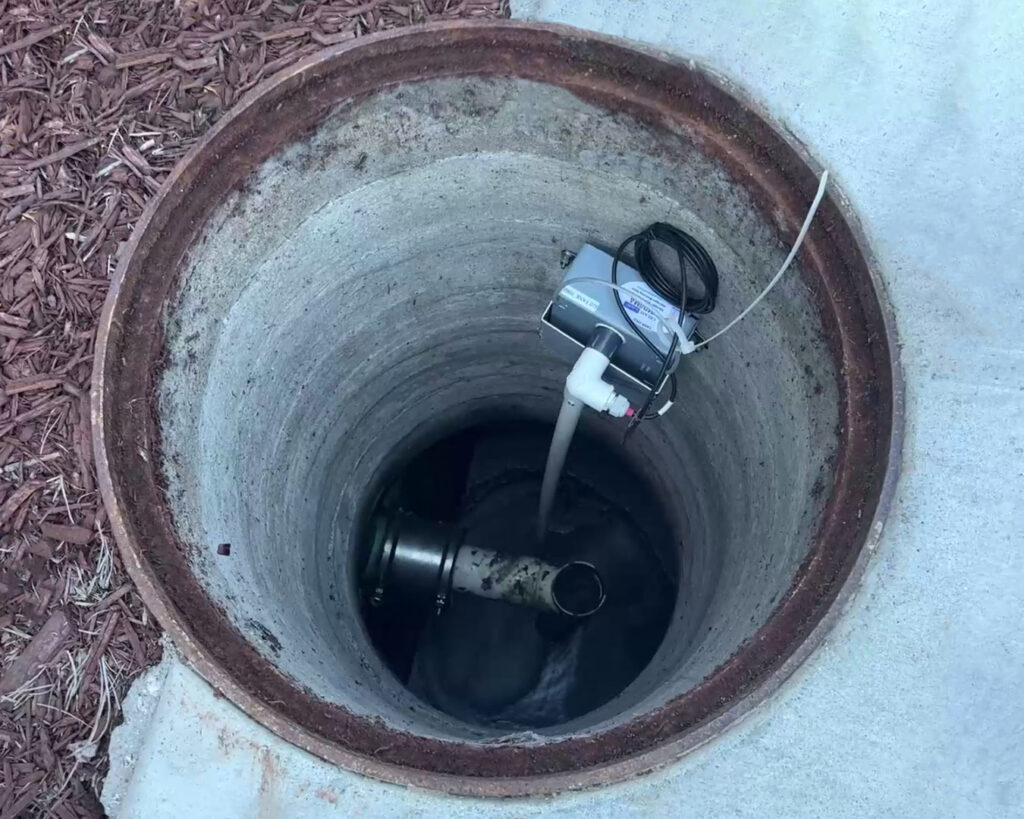
Overview: GreaseWatch is a wireless grease interceptor monitoring system (sold by Drain-Net Technologies) with a track record of field use since the early 2000swaterworld.comwaterworld.com. It uses ultrasonic sensors to measure floating grease/oil and settled sludge levels inside the trap, and transmits data to both an on-site alarm panel and a cloud portal. The latest GreaseWatch 5 (GW-500 series) comprises a battery-powered tank unit with an external ultrasonic transducer, a wall-mounted wireless gateway (with cell modem), and an indoor alarm displaydrain-tech.com. GreaseWatch gives continuous FOG and temperature readings and alerts you when the tank hits preset grease or solids capacity. It’s designed to prevent unnecessary pump-outs and backups by providing visibility into interceptor conditionsdrain-tech.com.
- Sensor Accuracy & Range: 9/10 – Employs fully potted ultrasonic transducers for level measurementdrain-tech.com. It measures the grease layer thickness, overall liquid depth, and even bottom sludge levels by analyzing the echo profiles. Accuracy is about ±1 inch within the typical operating rangedrain-tech.com. (Requires ~30″ static liquid depth to operate correctlydrain-tech.com, so suited for interceptors ≥150 gal capacity.)
- Integration & Remote Access: 10/10 – Supports dual wireless communication: a short-range RF link from the tank to the gateway, and cellular data uplink from the gateway to a secure web monitoring portaldrain-tech.com. Users can view tank levels online, get email/SMS alarms, and download compliance data. A local panel provides on-site audible/visual alarms. BMS integration is possible via optional relay outputs for high-level alarmsdrain-net.com.
- Ease of Installation & Retrofit: 9/10 – Installation is straightforward with no in-ground wiring. The battery-operated sensor unit mounts to the interceptor (e.g. inside a riser or manway) and a small antenna extends to surfacedrain-tech.com. The gateway and alarm panel plug into standard outlets inside the facility. GreaseWatch typically ships pre-configured; an installer can set it up within a couple of hours including calibration. (It meets strict codes like Miami-Dade, often required in retrofitsdrain-tech.com.)
- Data Logging & Compliance Reporting: 9/10 – GreaseWatch logs data to a cloud service (“IMD” portal) at regular intervalsdrain-tech.com. Facility managers can analyze daily level trends and receive automatic pump-out remindersdrain-tech.com. The system documents each time the grease and solids reach the alarm threshold, which helps with regulatory compliance recordkeeping (e.g. verifying that grease never exceeded mandated limits between pump-outswaterworld.com). Temperature monitoring helps ensure effluent stays within safe rangesdrain-tech.com.
- Durability & Certifications: 9/10 – The sensor and tank unit are built with corrosion-resistant polymers and sealed to IP/NEMA 4 standardsdrain-tech.com for use in corrosive wastewater. The wireless unit’s lithium battery lasts ~5 yearsdrain-tech.com. GreaseWatch is compatible with outdoor interceptors (weatherproof enclosure) and can handle typical grease trap temperatures. While not explicitly UL-listed as a system, it uses UL-recognized components. It complies with relevant plumbing codes (e.g. Miami-Dade DERM 2.0 ordinance) for grease monitoringipexna.com.
- Value & Support: 8/10 – At ~$5,000–$6,000 per unitdrain-tech.comdrain-tech.com, GreaseWatch is a significant investment, but it can quickly pay off by preventing blockages and optimizing pump schedules. The annual cellular service (~$300) is relatively low costdrain-tech.com for 24/7 remote monitoring. Drain-Net offers technical support and has experience deploying these systems nationwide. The product’s longevity (20+ years in market in various versions) means its reliability is provenwaterworld.comwaterworld.com. One minor consideration is that firmware updates or repairs require coordinating with the supplier.
Total Score: 54/60
Technical Specifications: Ultrasonic sensor (non-contact), accuracy ~1″drain-tech.com. Three-part system: Tank Unit (NEMA4, battery-powered, with ultrasonic probe and wireless transmitter), Gateway (wall-mounted, 110VAC, with RF receiver + 4G cellular modem)drain-tech.com, and Alarm Panel (110VAC, RF-linked, with siren and light). Monitors grease level, sludge level, liquid level, and internal liquid temperaturedrain-tech.com. Data upload via cellular to web app (with ~15-minute to hourly interval logging). Text/email alerts configurable. Dry contact relays available for external alarms.
Pros: Rich multi-point monitoring of grease and solids (helps avoid both grease clogs and sediment fill)drain-tech.com; Wireless install with no trenching; Web dashboard with daily data and compliance logs; Trusted by many restaurant chains and cities (meets municipal grease programs like Miami-Dade)drain-tech.com; Expandable – supports various models (from a basic local alarm-only GW-200 to the fully wireless GW-500).
Cons: Upfront cost is high for small operators; Requires periodic battery replacement (~5 years) and cellular subscriptiondrain-tech.com; Ultrasonic performance can be affected by extreme grease buildup or debris (maintenance needed to keep sensor clear). The multi-component setup (tank unit, gateway, panel) means more points of potential troubleshooting compared to simpler single-unit alarms.
Ideal Use Cases: Large restaurants, cafeterias, hotels and institutions that generate significant grease and want to avoid any sewer line incidents. Facilities under strict FOG ordinances or those using third-party pumpers – GreaseWatch provides an audit trail of interceptor conditions to hold haulers accountable and prove complianceblog.zurn.comblog.zurn.com. Also suitable for outdoor in-ground grease interceptors (the wireless signal and weatherproof design accommodate outdoor installs). Multi-site food service companies can deploy GreaseWatch across locations to centrally track grease levels.
Manufacturer/Product Page: See Drain-Net’s GreaseWatch product detailsdrain-tech.comdrain-tech.com and specifications.
🥉 HAWK IMD-3000™ FOG Monitoring System
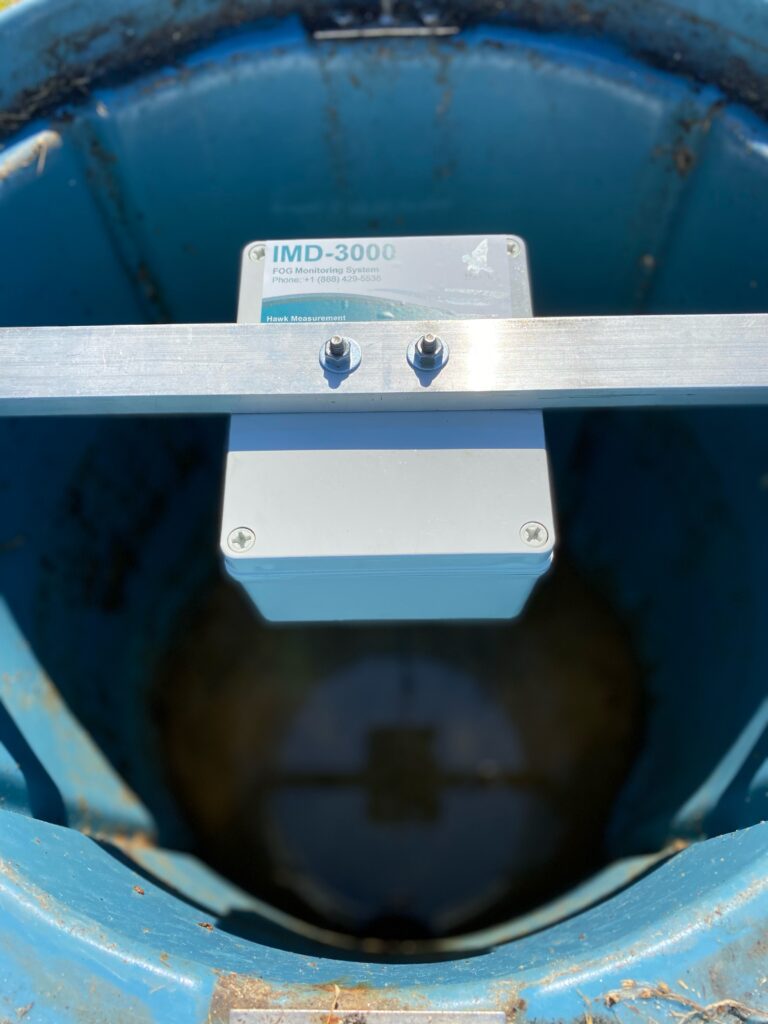
Overview: The HAWK IMD-3000 is an industrial-grade Fats, Oils, Grease (FOG) monitoring solution that brings advanced sensor technology to grease interceptors. Unlike ultrasonic-based systems, HAWK uses a Guided Wave Radar (GWR) sensor probe – the most reliable technology for stratified level measurement in harsh FOG environmentshawkmeasurement.com. This allows it to precisely detect the interface between water, grease, and solids without sensor fouling. The IMD-3000 is a self-contained unit typically installed on the interceptor’s access with a radar probe extending into the tank
. It features cellular connectivity to a secure cloud portal and can send real-time alerts via text/email. Designed originally for demanding industrial applications, the IMD-3000 carries extensive certifications (CSA, FM approvals for Class 1 Div 1 hazardous locations)hawkmeasurement.com, making it exceptionally durable. Leading restaurant chains have deployed HAWK’s system to prevent blockages and costly emergency pump-outshawkmeasurement.com.
Installation of a HAWK IMD-3000 unit on a grease interceptor. The guided-wave radar probe (inside the tank) measures grease, water, and sludge levels continuously, with data sent to a cloud dashboard.
- Sensor Accuracy & Range: 10/10 – Guided Wave Radar provides extremely accurate and continuous level readings. It measures the exact percentage of FOG and food solids in the tank by detecting the distance to each interface layerhawkmeasurement.com. Radar is unaffected by grease film, foam, or temperature, giving it a clear advantage over ultrasonics in dirty environmentshawkmeasurement.com. The probe can typically sense the full depth of most interceptors (and can be customized for various tank sizes).
- Integration & Remote Access: 9/10 – The IMD-3000 includes a built-in cellular modem and logs data to HAWK’s secure web portalhawkmeasurement.com. Users can access real-time dashboards remotely and receive SMS/email alerts before clogs occurhawkmeasurement.com. It can also forward alerts to building management or directly to service contractors (e.g. to dispatch a pumper when needed)hawkmeasurement.com. (Currently, direct BAS integration might require additional interface modules; the focus is on cloud-based monitoring).
- Ease of Installation & Retrofit: 7/10 – Installing the HAWK system involves mounting the controller and inserting the radar probe into the interceptor (usually through an existing lid opening or a new fitting). It requires power (typically 120VAC or 24VDC), so wiring is needed. The unit is compact, but professional installation is recommended to calibrate the radar for the specific tank geometry. While not as plug-and-play as battery wireless units, it’s still a retrofit-friendly design and HAWK provides commissioning supporthawkmeasurement.com.
- Data Logging & Compliance Reporting: 10/10 – All sensor data is logged and time-stamped on the cloud portal. This provides a detailed history of grease and solids accumulation, which is ideal for compliance reporting. The system can generate automated reports and send them to regulators if needed. It also tracks each pump-out event (the sudden drop in levels) for quality assurance, so you can confirm the interceptor was fully cleanedblog.zurn.comblog.zurn.com. The rich data (including temperature and pH if added) ensures FOG ordinance compliance is documentedhawkmeasurement.comhawkmeasurement.com.
- Durability & Certifications: 10/10 – Built for industrial environments, the IMD-3000 is explosion-proof rated (CSA Class I, Div 1 and ATEX/IECEx approvals) for use even where combustive sewer gases might be presenthawkmeasurement.com. The radar probe and enclosure are rugged and corrosion-resistant, designed to withstand hydrogen sulfide and harsh wastewater. This system can operate in extreme temperatures and carries CE and FCC certifications as well. It far exceeds typical interceptor monitor durability standards.
- Value & Support: 6/10 – The IMD-3000 is on the higher end of cost. Its superior reliability and the prevention of catastrophic clogs can justify the expense for high-risk or large-scale operations. However, smaller facilities might find the investment hard to swallow compared to simpler alarms. HAWK’s support is strong in terms of technical expertise – they often help with training and interpretation of data (the solution is often bundled with a service program to help facilities comply with local FOG programshawkmeasurement.com). There is likely an annual fee for the cellular data service and web portal. Overall, the value is excellent for mission-critical applications but might be overkill for a small restaurant on a tight budget.
Total Score: 52/60
Technical Specifications: Guided Wave Radar level transmitter (TDR/GWR) mounted on tank (usually top-mount probe). Accuracy: high (can detect multiple interfaces with precision ~0.1″). Sensor probe materials are typically PTFE-coated for FOG resistance. Controller enclosure: NEMA 4X, certified explosion-proof. Power: 85–265 VAC or 12–28 VDC options. Communication: 4G LTE cellular to cloud (with web dashboard and API options). Data: Measures and transmits grease layer %, solids %, total liquid level, and temperature. Alarms: High grease level, high solids, high liquid (blockage) alarms configurable. Compliance: Meets UL, CSA, FCC standards; certified for hazardous locations (Class I Div 1, etc.)hawkmeasurement.com.
Pros: Highest sensor reliability – radar is not affected by grease builduphawkmeasurement.com; Provides granular data (% grease and solids)hawkmeasurement.com for precise maintenance planning; Robust hardware with explosion-proof safety; Cloud portal with text/email alerts and rich analytics; Ideal for jurisdictions with strict FOG monitoring requirements (HAWK’s system was developed alongside county FOG ordinance initiativeshawkmeasurement.com).
Cons: Premium cost relative to other monitors; Requires power supply and more involved installation; Typically requires subscription for cloud service; Over-spec’d for small/simple applications (targeted more at enterprise or municipal users). Fewer installations to date compared to incumbents, so contractor familiarity might be lower (HAWK often works directly with customers for setup).
Ideal Use Cases: High-grease producers (large cafeterias, food processing kitchens, franchise chains with reputation to protect) that cannot risk a grease overflow. Also ideal for municipal or campus settings where multiple interceptors need monitoring (e.g. school districts, airports) – the radar accuracy helps ensure all sites stay within compliance. Facilities subject to aggressive FOG ordinances (e.g. South Florida countieshawkmeasurement.com) would benefit from the detailed compliance data. Any operation where sensor fouling has been an issue with ultrasonic or float-type monitors would find this radar solution invaluable.
Manufacturer/Product Page: See HAWK Measurement’s IMD-3000 FOG Monitoring descriptionhawkmeasurement.comhawkmeasurement.com and specifications for details on the radar technology and features.
🏅 Highland Tank FOGSWatch & High-LINK® Monitoring
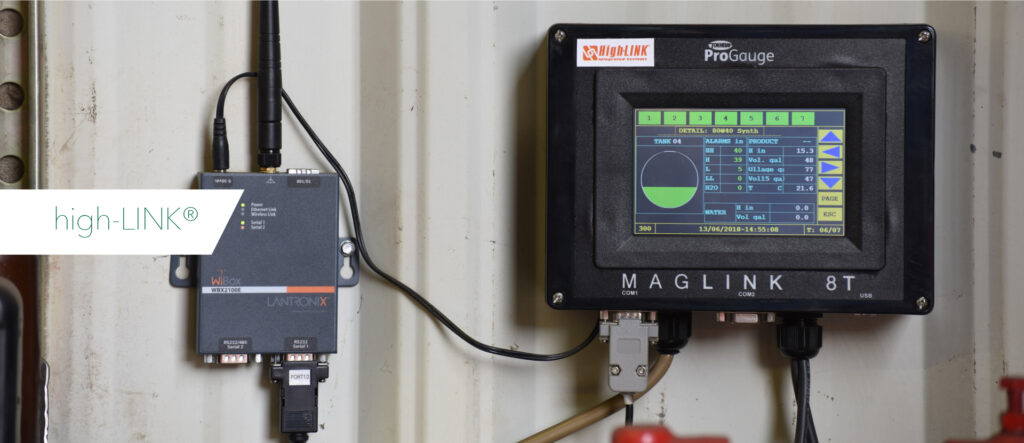
Overview: FOGSWatch by Highland Tank is a continuous level monitoring system for large grease interceptors, often paired with Highland’s industrial grease separators. It uses an ultrasonic transducer assembly to continuously monitor FOG and solids accumulation in the first chamber of a grease interceptorhighlandtank.com. Uniquely, Highland integrates FOGSwatch with its High-LINK® cloud platform for remote monitoring and asset management. This combination not only alerts when it’s time to pump the interceptor, but can also track pH levels, skimmer function, and preventive maintenance aspects in automatic grease removal deviceshighlandtank.comhighlandtank.com. The standard FOGSWatch setup includes a submersible sensor probe and a wall-mounted control panel with an LCD display and alarm. The panel can tie into a Building Management System via relayshighlandtank.com, and when connected to High-LINK®, data becomes available remotely in real-time. Highland’s solution is aimed at facilities with large or multiple interceptors where proactive monitoring can prevent environmental incidents.
- Sensor Accuracy & Range: 9/10 – FOGSWatch uses an ultrasonic level sensor probe installed at the interceptor’s tank centerline to detect the grease layer and solids levelshighlandtank.com. It provides continuous readings and can distinguish the accumulated FOG volume in the first chamber. Ultrasonic accuracy is high for liquid level and the system is calibrated to trigger alarms when grease or solids reach a specified limit (often 25% of tank volume). It may not pinpoint solids depth as precisely as a radar, but for the purpose of timely pump-out alerts it is very effective. The sensor placement is adjustable to fit various tank sizeshighlandtank.com.
- Integration & Remote Access: 10/10 – When used with High-LINK®, Highland’s monitors offer extensive remote capabilities. The High-LINK cloud dashboard provides real-time data access “from anywhere, on any device,” plus predictive alerts and customizable reportinghighlandtank.comhighlandtank.com. It can email alarms to waste haulers automatically when service is duehighlandtank.com. The control panel itself includes aux contacts to connect with on-site building automation or alarm systemshighlandtank.com. Essentially, you get both local and cloud monitoring. High-LINK can also integrate other data (pH sensors, flow, etc.), giving a comprehensive view of interceptor performance.
- Ease of Installation & Retrofit: 7/10 – The FOGSWatch sensor typically is mounted through a pipe riser or manway using provided adaptershighlandtank.com. It must be wired (via CAT-5 cable) back to the control panel (up to 200′ away)highlandtank.comhighlandtank.com. This means installation involves running conduit or cable from the trap to a nearby wall indoors, which is a moderate effort in retrofit scenarios. However, the system is designed to be field adjustable and fits both indoor and outdoor interceptorshighlandtank.com. Total install time is often a day’s work for an electrician/technician. Once installed, it’s virtually maintenance freehighlandtank.com – the sensor has no moving parts and the panel self-diagnoses issues.
- Data Logging & Compliance Reporting: 10/10 – In a High-LINK connected setup, all FOG level data is logged in the cloud. Users can get automated compliance reports and alerts when maintenance is neededhighlandtank.comhighlandtank.com. The system verifies when cleanings have occurred (High-LINK shows a drop in levels post-pump) and even detects if someone tampered or skipped service (e.g. “verifies cleaning, prevents tampering” as Highland noteshighlandtank.com). For environmental compliance, these records help demonstrate that the interceptor was maintained properly. The platform can also track effluent quality (pH, etc.) for regulatory purposeshighlandtank.com.
- Durability & Certifications: 9/10 – Highland Tank builds heavy-duty equipment, and FOGSWatch is no exception. The sensor and controller are designed for harsh wastewater conditions (the panel is UL-listedhighlandtank.com and NEMA-rated). Materials are corrosion-resistant PVC and stainless steel. The system is made in the USA and tailored for large grease separators which often sit underground – the components can handle moisture and moderate temperature swings. (For extremely hazardous areas, one might need an explosion-proof variant, but typically grease interceptors are not classified as Class 1 Div 1.) Overall, with proper installation, FOGSWatch hardware is very long-lasting.
- Value & Support: 6/10 – This solution is positioned for high-capacity interceptors and is usually sold as part of a larger system (often specified with Highland’s GreaseStopper® or large passive interceptors). Thus, the cost can be substantial, though exact pricing is case-specific. For those who need it, the value is in averting major environmental spills and fines. Highland offers strong technical support directly and through rep firms. The High-LINK software subscription cost is something to factor in, but it adds significant value by reducing labor in monitoring. Because it’s a premium, integrated solution, it may be over-featured for a small restaurant – the sweet spot is bigger facilities where manual monitoring is impractical.
Total Score: 51/60
Technical Specifications: Ultrasonic level sensor (Cat-5 wired) with PVC housing, installed in interceptor chamber (either via 1.5″ NPT tap or under manway cover)highlandtank.com. Control Panel (HT-2823 model): UL 61010 listed, NEMA 4X enclosure, 120VAC power. Panel has LCD display of grease and solids levels and an audible alarm. Relay outputs for high grease and high liquid (for BMS or external alarm) are included. When connected to High-LINK®, panel data is transmitted via a cellular or Ethernet gateway to cloud. High-LINK software provides multi-tank monitoring, alarm notifications, data logging, and reportinghighlandtank.comhighlandtank.com. The system can monitor additional parameters (like pH sensors in the interceptor) via the High-LINK integrationhighlandtank.com.
Pros: Designed for large interceptors and multi-unit facilities; continuous monitoring prevents catastrophic overflows; integrates grease and solids tracking with broader facility management (High-LINK can monitor multiple systems – fuel tanks, oil-water separators, etc., in one dashboardhighlandtank.com); compliance-friendly with automatic reporting; sensor is maintenance-free and long-lived; backed by a reputable tank manufacturer.
Cons: Installation is wired and more involved (not ideal if running new conduit is very difficult at a site); cost is high, especially if only used as a standalone grease monitor without leveraging the full High-LINK platform; smaller grease traps (<150 gallon) may not justify this system. High-LINK cloud monitoring likely involves ongoing fees. Geared more toward new construction or major retrofits, so it may not be readily available “off the shelf” like some plug-and-play units.
Ideal Use Cases: Institutions and commercial kitchens with large grease interceptors – e.g. hospitals, prisons, universities, central cafeterias – where a spill or backup would be disastrous. Ideal for operations that already use Highland Tank solutions or want an enterprise-grade monitoring network (e.g. a corporate campus managing multiple separators). Also a top choice for facilities in municipalities that encourage or mandate automated FOG monitoring for larger volume interceptors (the system meets specific code requirements like Miami-Dade’s standardsipexna.com). If you have an automatic grease removal unit (AGRU), FOGSWatch/High-LINK can even monitor the equipment’s operation (like the rotating skimmer disk) to ensure the device is functioninghighlandtank.com.
Manufacturer/Product Page: See Highland Tank’s FOGSWatch brochurehighlandtank.comhighlandtank.com and High-LINK® platform infohighlandtank.com for features and installation details.
🗂 Comparison Table of Top 5 Systems
| System | Sensor Type & Accuracy | Integration (Remote Access) | Installation (Retrofit Ease) | Data Logging & Reports | Durability/Certifications | Value & Support | Total (60) |
| Zurn SmartPro (🥇) | Ultrasonic, ±1″drain-tech.com | Wireless RF + Cellular; Cloud & BASblog.zurn.com | Battery sensor; <1 hr installblog.zurn.com | Yes – cloud logs, pump logsblog.zurn.com | NEMA4X; UL compliantzurn.com | High cost, strong ROI & supportblog.zurn.com | 55 |
| Drain-Net GreaseWatch (🥈) | Ultrasonic, ±1″ | Wireless RF + Cellular; Web portaldrain-tech.com | Battery sensor; easy retrofitdrain-tech.com | Yes – daily cloud datadrain-tech.com | NEMA4; Miami-Dade compliantdrain-tech.com | High cost, proven savings | 54 |
| HAWK IMD-3000 (🥉) | Radar (GWR), very high | Cellular; Web portal, SMS alertshawkmeasurement.com | Powered sensor; pro install | Yes – detailed logshawkmeasurement.com | XP-rated (Cls 1 Div1)hawkmeasurement.com | Very high cost, niche support | 52 |
| Highland FOGSWatch | Ultrasonic, high | Ethernet/Cell via High-LINKhighlandtank.com; BAS relayhighlandtank.com | Wired sensor; moderate effort | Yes – with High-LINK cloudhighlandtank.com | UL panel; industrial buildhighlandtank.com | Premium cost, tailored support | 51 |
| IPEX/Canplas (Labkotec) GA-2 | Capacitance/Conductivity (point sensor)manuals.plus | Local panel; dry contacts for BAS | Wired probes; moderate effort | Limited – alarm only | UL 61010; CSA; IP68 sensorsipexna.comipexna.com | Low cost, basic compliance | 41 |
Table: Quick comparison of the top grease interceptor monitors. Higher total scores indicate more advanced capabilities, but the best choice depends on facility needs and budget.
🧭 How to Choose a Grease Interceptor Monitoring System for Commercial Kitchens
Selecting the right grease trap monitor requires balancing technology, compliance, and cost for your specific situation. Here’s a buyer’s guide with key factors and tips:
1. Assess Your FOG Generation and Compliance Needs:
Consider the volume of fats, oils, and grease your kitchen produces and any local regulations. High-FOG generators (like busy restaurants or cafeterias) and jurisdictions with strict ordinances (e.g. some counties now require grease interceptor monitoringhawkmeasurement.com) will benefit from a more robust system. If regulators demand documented pump schedules or alarms at 25% grease capacity, choose a system known for compliance reporting (SmartPro, GreaseWatch, High-LINK, etc.). Smaller establishments with lower output might suffice with a simpler alarm if codes allow.
2. Sensor Technology – Know the Trade-offs:
Monitoring systems use different sensor principles – ultrasonic, resistance, capacitance, or radar – each with pros and cons:
- Ultrasonic sensors measure through sound wave reflections. They enable real-time monitoring and can even distinguish sludge vs. water layersnewea.org. Ultrasonics are used in many top systems (SmartPro, GreaseWatch, FOGSWatch) for continuous data. Cons: They can foul or give false readings if grease coats the transducer, so some maintenance/cleaning is needednewea.org. They also require a minimum liquid depth to work properly.
- Resistance (Conductivity) probes use electrical resistance changes to detect oil versus water contact. These are found in basic alarms (e.g. Alderon GOOP) – they are simple, low-cost, and robustnewea.org. Cons: They only provide point-level alarms (no continuous level data) and can be easily fouled by grease insulating the probesnewea.org. Resolution is limited to “alarm or okay.”
- Capacitance sensors detect FOG via changes in dielectric constant. They are relatively affordable and less prone to fouling than bare conductivity probesnewea.org. Labkotec’s GA-2 uses this principle. Cons: Resolution is still discrete (trips at setpoint) and it might not reliably sense the exact grease-solids boundarynewea.org – essentially it tells when it’s time to pump, not how much grease continuously.
- Radar (Guided Wave Radar) is the high-end option – very accurate and not affected by grease builduphawkmeasurement.com. It can continuously measure multiple layers. The HAWK IMD-3000’s radar, for example, gives precise FOG percentagehawkmeasurement.com. Cons: Cost is higher and installation is a bit more involved. It’s usually justified for large or critical systems.
Match the sensor to your operational needs and budget. If you just need a compliance trigger at 25% capacity, a capacitance/resistive alarm or basic ultrasonic alarm might do. If you want rich data or have had issues with sensors failing due to grease, consider investing in higher-grade ultrasonics or radar.
3. Integration: Standalone Alarm vs. Connected Smart System:
Decide if you need remote monitoring. Basic systems will just flash a light or buzzer on-site when pumping is needed. This might be fine for a single-location restaurant where staff can check the panel daily. However, if you manage multiple locations or want to outsource oversight to a service company, a connected system is invaluable. IoT-enabled monitors (like SmartPro, GreaseWatch) will send you alerts via SMS/email and let you check interceptor status from a phone or PChawkmeasurement.com. Some can tie into the Building Automation System (BAS) so that high grease alarms show up on your facility dashboardshighlandtank.com. Systems like High-LINK even allow automatic notifications to pump contractorshighlandtank.com.
For facilities with staffing challenges or infrequent manual inspections, remote access is a game-changer. Just note connected systems often carry monthly or annual fees for cellular or cloud service – budget accordingly.
4. Installation Considerations:
Retrofitting an existing grease interceptor with a monitor can range from very easy to moderately complex:
- Power Source: Can you easily get power to the monitor? If not, lean towards battery-powered options (SmartPro, GreaseWatch) that avoid running new electrical lines. If power is available, wired systems are fine and may offer more robustness for long-term use.
- Wiring Runs: Determine how you will route sensor cables. Fully wireless systems eliminate this concern – they use radio transmitters on battery. Wired sensors (e.g. Labkotec GA-2 or FOGSWatch) need a conduit from the tank to an indoor panel. This might involve minor trenching or drilling through walls. In new construction, it’s smart to specify a conduit from the grease interceptor to a convenient panel location for future monitoring equipment.
- Physical Mounting: Check how the sensor will mount. Many come with universal brackets for manholes or risershighlandtank.com – ensure your interceptor lid can accommodate that. If space is tight (e.g. small under-sink traps), a low-profile probe or external mount might be needed. Some monitors are not recommended for very small hydromechanical traps (often require ≥100 gal volume to work well). Always verify the compatible tank sizes in the product specs.
5. Data and Reporting Needs:
If you simply want to know when to pump, a basic alarm with no data logging is sufficient. But if you need to prove compliance or optimize pumping intervals over time, look for systems with data logging capabilities. Smart monitors can track how fast grease is accumulating – this helps in adjusting your pumping schedule to actual needs (demand-based pumping). They also provide records to satisfy inspectors that you never exceeded allowed grease levels between serviceswaterworld.comwaterworld.com. For example, SmartPro and High-LINK allow you to confirm that interceptors were cleaned and remained in good condition, which can protect you from fines. Some jurisdictions may even accept electronic logs in lieu of paper manifests. So, choose a system with at least basic memory or cloud logging if reporting is a priority.
6. Durability and Environment:
Grease interceptors can be in tough environments – outdoors in manholes, subject to temperature swings, or indoors in hot kitchens. Ensure the monitor you pick is rated for those conditions:
- Weatherproofing: For outdoor installations, an IP/NEMA rated enclosure (NEMA 4X or IP65 and above) is a must so rain or humidity won’t damage itdrain-tech.com. All the top systems above have waterproof components.
- Corrosion Resistance: FOG waste can produce hydrogen sulfide and other corrosive gases. Look for sensors made of PVC, Teflon, stainless steel, or other corrosion-proof materials. Avoid cheap electronics not meant for wastewater.
- Certifications: While grease interceptors aren’t typically classified as explosive hazard areas, it’s reassuring if the device has UL or CSA electrical listings and has been tested for safetyipexna.com. If your interceptor is in a confined space with potential methane (more common in sewage wet wells than grease traps), you might consider a system with an explosion-proof rating for extra safety (like the HAWK radar which is Class I Div 1 ratedhawkmeasurement.com). For most kitchens, standard ratings are fine. Also, NSF certification is not common for monitors, but some sensor systems might have third-party validation for FOG use.
7. Budget and ROI:
Prices for FOG monitoring systems vary widely:
- Basic alarms (point-level floats or probes) can be a few hundred dollars up to ~$1k.
- Mid-level smart monitors (ultrasonic with remote monitoring) are typically in the $5k range plus ~$20–30/month for cloud service.
- High-end radar systems or multi-sensor networks can run into several thousands plus service fees.
Calculate the return on investment: How much can you save by reducing pump-out frequency? For instance, if you currently pump monthly at $300 each, but a monitor shows you only need it bi-monthly, that’s $1,800 saved per year – which can justify a $5k system over its life. Also factor in the cost of a backup or overflow: one major grease blockage that floods your kitchen or causes a public sewer spill can cost tens of thousands in cleanup, fines, and lost business. A monitoring system is cheap insurance in that context.
If budget is tight, you might start with one monitored location as a pilot. Some service providers offer monitors on a rental or subscription basis as part of a pumping contract, which can convert the capital expense into an operating expense. Also, check if your city or water utility offers any incentives – a few progressive municipalities encourage FOG automation to reduce sewer clogs, possibly with rebates or credits.
8. Support and Maintenance:
Consider who will install, calibrate, and maintain the system. Does the manufacturer offer phone support or training? Are there local distributors or contractors familiar with it? Systems from major players (Zurn, Highland, etc.) often have better local support through reps. Others might rely on factory support remotely. Also, clarify maintenance requirements: e.g., battery replacement schedule (typically 3-5 years for wireless units) and any sensor cleaning routine. Ensure spare parts (like replacement probes or cables) are available. Reading reviews or case studies can shed light – for example, SmartPro is noted for minimal maintenance and easy installblog.zurn.com, whereas older float-based alarms might need frequent checks.
Finally, think about expansion – if you might add more interceptors or want to monitor grease traps across multiple properties, choosing a system that can scale or integrate into one platform will make life easier. High-LINK and similar platforms are designed for multi-unit oversighthighlandtank.com.
By evaluating these factors – FOG volume, sensor type, connectivity, install effort, data needs, durability, cost, and support – you can select a grease interceptor monitoring system that best fits your commercial kitchen. The right choice will keep your facility in compliance, prevent nasty grease backups, and ultimately save you money by streamlining grease management. Safe and smart grease trap monitoring will protect both your operations and the environment. newea.orgnewea.org
